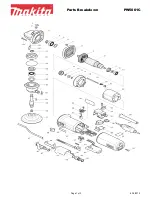
-28-
Model G1066R/Z/G1079R (Mfd. Since 02/11)
SECTION 4: OPERATIONS
Operation Overview
To reduce your risk of
serious injury, read this
entire manual BEFORE
using machine.
Eye injuries, respiratory problems, or hear-
ing loss can occur while operating this
tool. Wear personal protective equipment to
reduce your risk from these hazards.
If you are not experienced with this type
of machine, WE STRONGLY RECOMMEND
that you seek additional training outside of
this manual. Read books/magazines or get
formal training before beginning any proj-
ects. Regardless of the content in this sec-
tion, Grizzly Industrial will not be held liable
for accidents caused by lack of training.
Keep hair, clothing, and
jewelry away from mov-
ing parts at all times.
Entanglement can result
in death, amputation, or
severe crushing injuries!
To complete a typical sanding operation, the
operator does the following:
1. Examines workpiece to verify it is suitable for
sanding and determines which sandpaper
grit size to use.
2. Verifies workpiece has necessary outfeed
clearance and support. If workpiece is overly
long and difficult to handle, operator uses a
roller support stand or an assistant to assist
with feeding.
3. Adjusts table height to approximate workpiece
thickness.
Note: During initial pass with a new workpiece,
operator adjusts table height as necessary
so workpiece only makes light contact with
sanding belt and does not overload sander.
4. Puts on safety glasses, respirator, and any
other required protective equipment.
5. Starts dust-collection system, and then drum
sander. Waits for sanding drums and con-
veyor belt to reach full speed. If equipped,
sets conveyor speed for the specific type and
finish of workpiece.
6. Feeds workpiece into sander by placing front
end on infeed side of conveyor table and
supporting back end until workpiece engages
with pressure rollers.
7. Receives workpiece from outfeed side of
conveyor table.
8. Raises height of conveyor table a small
amount (typically
1
⁄
4
of a full rotation of crank
handle), then repeats the feeding process of
workpiece through sander.
9. Changes sandpaper to a finer grit, as needed.
10. Repeats Steps 6–9 as needed, turns sander
OFF, and disconnects it from power.
















































